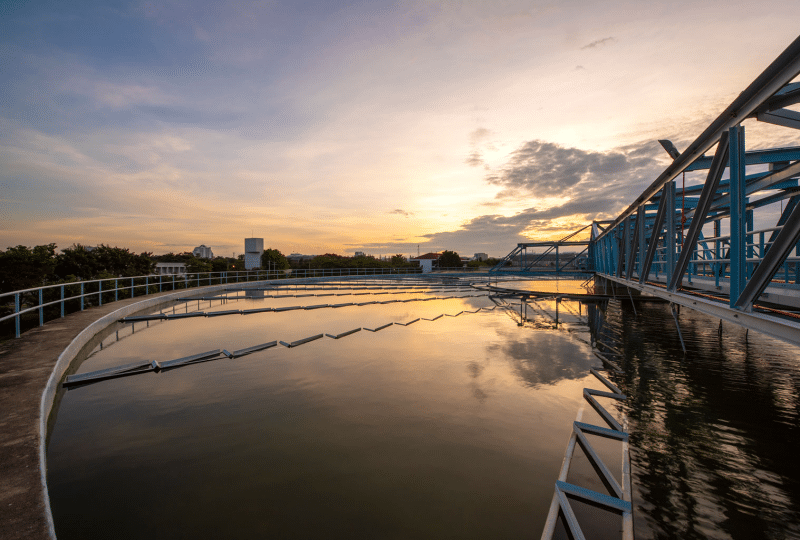WATER TREATMENT
Water is essential for all living and nonliving organisms. Did you know that only 3% of the available water on the earth is clean and drinkable? Glaciers lock up 2.5% of the water leaving only 0.5% available freshwater for daily consumption in the world.
A water treatment plant is a facility that is used to purify water for various uses such as drinking, irrigation, industry, and other applications. Water treatment plants eliminate impurities such as bacteria, sediment, dissolved minerals, and other contaminants from water to make it safe and suitable for its intended use.
TYPES
There are various types of water treatment plants, but the most common include surface water, groundwater, wastewater and desalination.
Surface Water
A surface water treatment plant is a facility that is used to purify water from lakes, rivers, or other surface sources. The water is treated through a number of processes to take out the impurities and make it safe for drinking, irrigation, industry, and other uses.
The main stages of treatment in a surface water treatment plant include:
- The first stage of treatment is pre-treatment, and it typically entails removing larger particles and debris from the water using screens or other mechanical devices.
- The coagulation stage includes adding chemicals such as alum or iron salts to the water, which causes small particles to clump together and form larger particles called flocs.
- The flocculation stage includes gently mixing the water to encourage the formation of flocs, which can be more easily removed in the next stage.
- Next is the sedimentation stage which involves allowing the flocs to settle to the bottom of a sedimentation basin, where they can be removed from the water.
- The filtration stage involves passing the water through a series of filters to remove particles and other impurities. The filters can be made of sand, gravel, or other materials, and they are designed to remove particles of different sizes.
- The disinfection uses chemicals or UV light to kill any remaining bacteria or other microorganisms in the water. This is typically done using chlorine or other disinfectants, or by passing the water through a UV light chamber.
- The adjustment of pH is the stage that is used to adjust the pH of the water to ensure that it is safe for drinking or other uses. The pH of the water is typically adjusted using chemicals such as lime or carbon dioxide.
- The stage of tertiary treatment includes removing specific contaminants such as nitrates, heavy metals, and other dissolved minerals by using specialized processes such as ion exchange, reverse osmosis, or adsorption.
- The post-treatment stage is when the water is typically stored in a clear well or a holding tank before being distributed to consumers.
- Regular monitoring and testing of water quality is done to ensure that the water meets the required standards for drinking and other uses.
Not all surface water treatment plants will have all these same stages, as it depends on the specific water source and the value of the surface water. Some plants may have additional stages depending on the specific contaminants present in the water and the intended use of the water.
Groundwater
A groundwater treatment plant is a facility that is used to clean water from wells or underground aquifers. Groundwater is water that is found underground and is typically accessed through wells. The water is treated through a series of methods to eliminate impurities and make it safe for drinking, irrigation, industry, and other uses.
The treatment process typically includes eliminating physical, chemical and biological contaminants, as well as altering the pH level of the water to make it safe for consumption. The plant may also contain additional stages of treatment depending on the specific contaminants present in the water, such as deleting heavy metals, nitrates and other dissolved minerals using specialized processes such as ion exchange, reverse osmosis, or adsorption.
The treated water is then kept in a clear well or a holding tank before being delivered to consumers. The plant is also observed and tested regularly to ensure that the water meets the required standards for drinking and other uses.
Wastewater
These plants treat water that has been used and is now contaminated with human waste, industrial waste, or other pollutants. The water is treated through a series of processes such as sedimentation, aeration, filtration, and disinfection.
There are 4 main stages in the wastewater treatment process which include preliminary, primary, secondary and tertiary.
The objective of a wastewater treatment plant is to achieve water quality standards in line with water safety regulations. This is a continuing process that allows us to enjoy safe, clean drinking water straight from the tap.
Desalination
A desalination water treatment plant is a facility that removes salt and other dissolved minerals from seawater and brackish water to make it reliable for drinking, irrigation and other uses. The steps of removing salt from seawater is known as desalination. Desalination plants are normally used in coastal areas or regions where freshwater resources are scarce and can be a vital source of clean drinking water for communities and industries.
There are 2 main types of desalination processes: thermal and membrane. The thermal desalination method, such as multi-stage flash (MSF) and multi-effect distillation (MED), uses heat to vaporize seawater, leaving behind the dissolved salts. The vapor is then chilled, condensing it back into freshwater. Membrane desalination methods, such as reverse osmosis (RO) and electrodialysis (ED), use semi-permeable membranes to filter out dissolved salts and other contaminations.
Desalination plants can be large-scale facilities that offer water to entire communities, or they can be smaller, distributed facilities that provide water to certain facilities or industries. While desalination is an effective way to offer freshwater in areas where water resources are scarce, it can be costly and energy intensive.
GOAL
In general, the goal of a water treatment plant is to purify water so that it is safe and fit for its intended use. Water treatment plants play a crucial role in protecting public health and the environment by providing safe drinking water and reducing water pollution.


